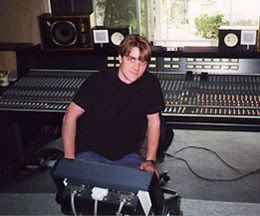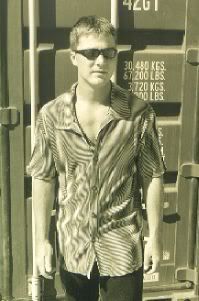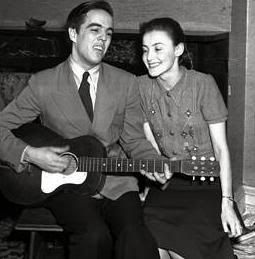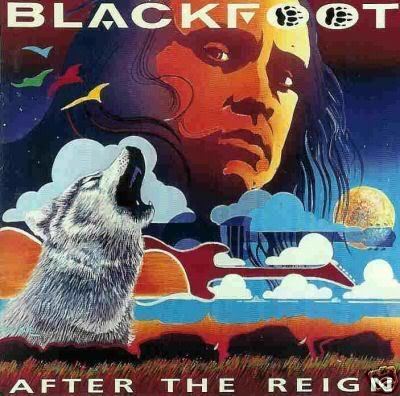
By STEVE SEYMOUR
Ex-Escanaban Kevin Chown's music career has taken him around the world, but it wasn't until 2003 that he got a proper homecoming.
At last count he has performed in 41 states, eight countries and four continents A professional musician since age 15, Chown has gigged with rocker Uncle Kracker, Motor City madman Ted Nugent, jazz master George Benson, teen idols Hanson, country newcomer Ashley Jay and many acts on the oldies circuit.
In addition, he's recorded with an impressive list of artists including Tony Macalpine, Artension, Magnitude Nine and Jeff Kollman. His composing talents have been utilized by the Detroit Red Wings, Detroit Tigers, Little Caeser's Pizza and the Weather Channel.
Chown's journey into rhythm and melody started in Escanaba where he grew up in a musical family. His father (John) was his high school band teacher while his mom (Ruth) gave private piano lessons. In 9th grade, choral teacher John Beck played "Heavy Metal Be-Bop" by the Brecker Brothers for Chown. "I remember literally being blown away from the first note. I knew exactly what I wanted to do," Chown said of the experience.
"Watching Ruby Starr from through the door at the old Sherman Lounge, watching the Lark Brothers at the old Lark's Bar on 10th St., seeing Mark Woerpel come back to town with his bands, I guess in a nutshell, I feel blessed to come from a small town like Escanaba. But, I didn't realize it when I was there."
Chown began performing professionally at age 15, first on drums with a country band from Norway. "Shortly after, I switched to bass. By the time I was 19 I had already played over 100 gigs. Most people my age hadn't played any." After a year at Bay College, Chown moved to Detroit to attend Wayne State University. Due to the practical skills he learned performing in the U. P., he was able to start working immediately in southeastern Michigan.
He earned a bachelor's degree in jazz studies and was named "instrumental soloist of the year" at the Montreau-Detroit Jazz Festival for his rendition of a track from the Brecker album which had influenced his music career years earlier. In Detroit, he got busy recording his first solo album, "Freudian Slip" in his 12th story studio apartment. "I think I drove my neighbors crazy," Chown recalled. Some of the original writing for that album was done in Escanaba.
Now a resident of Los Angeles, Chown, his friend "and long-time partner in crime" Jeff Kollman, and Charle Waymire record as JKB. The group is nearly finished with a new record but is on hiatus while Kollman plays guitar for Glenn Hughes, former singer for Deep Purple who is on a world tour for the next few months.
Chown has also planned a new solo compact disc for some time. "I actually just started doing a bunch of new songs with a software package that I bought and am having a good time doing some electronica based things, with bass. I want the next record to be very jammy and spontaneous. I'm thinking of doing a vocal record actually."
Chown's career is moving along swiftly. He's musical director of a show called Royal Jelly, which is running twice weekly at a Hollywood club called Ivan Kane's Forty Deuce. In addition, Chown's band appeared recently on the late night talk show, "Jimmy Kimmel: Live." Carson Daly has also made inquiries for an appearance this spring.
Even while he's busy in California, Chown finds a connection to the U. P. "Just in LA, I have friends from Escanaba, Gladstone, Ironwood, Munising, Marquette, Houghton and the Soo. The list goes on. I usually have them all over for at least one Packers game."
Chown looks favorably on his early years in northern Michigan. "Without that time in the trenches in the Upper Peninsula, I would not be where I am today. I can think of others who have gone on to success that probably would say the same. Brian Lord, Steve Huebler and Catte Adams, would be a few."
While the U. P. provided Chown with that early experience, it also welcomed him back on Nov. 7 & 8, 2003.
That's when Chown brought his booming bass to the Island Resort & Casino as a member of the Uncle Kracker band, hot at the time for "Drift Away," "In a Little While," and "Memphis Soul Song."
"I had a great time when I was back in town with Kracker. In a way, it was a homecoming as it was the first and only time that I have performed in Escanaba since I moved away, except for a recital I did at the Bonifas Arts Center. I dragged Kracker and the boys out to Mueller's Pizza after one of the shows. It was a riot. It was great to see so many friends I hadn't seen in years."
Chown left the Kracker band a few weeks later when the tour ended. He moved on to other things in LA where he was offered work on movie soundtracks, trailers and TV scores.
"I still do a lot of that in addition to a great deal of live performance. By ending my time with Kracker with a concert in my hometown did give it special meaning. It was the perfect place to let go of the gig and move to greener pastures. I had a blast while it lasted, however."
While he has rarely performed in Escanaba in recent years, Chown returns often to see his family and visit some of his old haunts.
IN HIS OWN WORDS:
CHOWN'S ADVICE TO ASPIRING MUSICIANS
"First off, keep at it. You might not know it, but you have a proud Escanaba rock legacy to live up to. There have been some great musicians to come out of Escanaba. Always remember that it doesn’t matter where you start. Being in Escanaba can rightly seem like a million miles from what you dream of. But use the time you have there to find your own identity. If you have integrity and if you truly love doing what you do, things have a tendency to find you, no matter where you are. Find yourselves while you are there. Be true to the art and learn about the business. Be smart but be courageous. And don’t let anyone tell you that you can't." 
IN HIS OWN WORDS:
CHOWN DESCRIBES THE U. P. CONNECTION
"I always find it amazing that almost every situation I have been in musically or in life in general, there can always be found a connection to the U. P. The oddest was when I was in the Middle East. I was backing a country singer named Ashley Jay and it was one of those escorted tours where we played for the military just before the Iraq war started in 2003. First off, the guitar player who I hired for the gig turns out to be from AuTrain. Then, we would be in the middle of nowhere, miles and miles out in the Kuwaiti Desert, playing at these weird desert fortresses. After the show, the troops and the band would be hanging out. So, I’m talking to one guy. Totally has the U. P. accent. After a few minutes, I had to ask, 'Where you from, soldier?' Turns out he was from Gwinn. He knew my high school girlfriend's ex-husband who used to be stationed at K.I. Sawyer Air Force Base. Yes, we live in a small world. And it gets smaller every day if you can believe it. Always amazes me!"
FAST FACTS ABOUT KEVIN CHOWN
Favorite Old Record: Marvin Gaye: “What's Goin' On”
Favorite New (er) Record: U2: “How To Dismantle an Atomic Bomb”
Recent Significant Discovery: Donny Hathaway: “LIVE”
Best Concert: U2, Beth Hart, Michael Brecker, Trilok Gurtu, Mike Stern, Tribal Tech
Coolest Artist Worked With: Hanson. Totally cool, generous, humble guys. And talented.
Worst Artist to Work With: Martha Reeves. Hands down.
Favorite Escanaba Haunts: Baron's, Buck Inn, Catman’s, Breezy, Stonehouse, Delona, Mueller's, Sub Shop, Mr. Bike, Kobasic Market, IGA
Most Missed Escanaba Haunts: Crispigna’s, Mr. Ed’s Grotto North, Sherman Lounge, Big Al’s, Hob Nob, Spars, Whiffletree, Holiday Bowl
Thing I love About Escanaba: The simplicity of the lifestyle.
Favorite Celebrity I’ve Met In LA: Mr. T. Sting is a close second.





